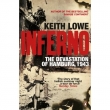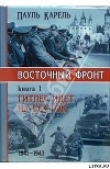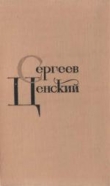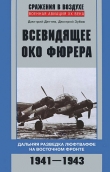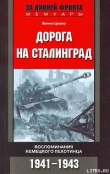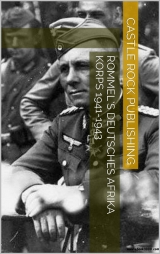
Текст книги "Rommel's Deutsches Afrika Korps 1941-1943"
Автор книги: Автор Неизвестен
Жанры:
История
,сообщить о нарушении
Текущая страница: 6 (всего у книги 19 страниц)

The Axis armies and their leaders underwent yet another reorganisation as a result of which Gariboldi was replaced as Italian commander-in-chief by Bastico. A Panzer Group Rommel was formed out of the amalgamation of the old 5th Light, 15th Panzer, and an Africa Division, a conglomeration of units serving in North Africa. An Italian Corps also came under command of Panzer Group Rommel.
The attack upon Tobruk which the German commander-in-chief had been pressing to undertake and which had been proposed for August was then postponed until November but Rommel, who had been warned by his Italian superiors to be cautious, was determined to keep the operational initiative in his hands for, if he did not, then the British would grow in strength and their offensive operations would become more numerous and heavy. But in September patrol activity gave no indication of a British build-up for an offensive and secure in this knowledge Rommel increased the tempo of his preparations to reduce Tobruk. As a result of the knowledge which he had gained from personal reconnaissance and with the experiences of earlier battles upon which to draw he changed the plan of attack. The new thrust line would be from the south-east and to distract the attention of the garrison while the main attack went in, 'Chinese' assaults (decoy attacks) would be launched. Two German and two Italian divisions were to carry out the actual attack and this was to be supported by 200 guns. The supply situation deteriorated again and this was one of the excuses advanced by Commando Supremo which caused the date of the opening of the Tobruk offensive to be postponed. The non-arrival of an Italian motorised division was the principal reason given for the postponement but Rommel decided to make his attack with or without the promised Italian support. He knew that his own units were under-strength and that the Luftwaffe^ forced by Hitler's direct order to protect the merchant marine convoys, could not spare aeroplanes to carry out air bombardments of the town but nevertheless he was determined to go ahead. [9]

As examples of the shortages which he was facing one division of the Africa Corps was 4000 men short of its war establishment and for the whole Corps no less than 11,000 men were needed to bring the units up to strength. Losses to convoys were enormous and losses of 50 per cent were not uncommon. It is not surprising, therefore, that the artillery establishment of Africa Corps was 66 per cent of its total and that reinforcements were not reaching the combat units. In one two-month period only 7640 men were disembarked, of whom 2640 came by air.
Determined to reduce Tobruk, Rommel then put his troops through a period of intensive training and by mid-November the preparations had been completed. The heaviest concentration of Axis artillery seen in the desert to that time, no less than 461 guns of all calibres, were in position around the town. With the troops trained and the battle plan drawn up, the artillery fired-in, and the tanks fuelled the Africa Corps and its Italian allies waited in the cold winds and rainy days of November 1941 for the attack to open.
Meanwhile, to the east Rommel's greatest fear had been realised; 8th Army had prepared itself for battle and had struck the first blow. Auchinleck, successor to Wavell as Commander-in-Chief had opened Operation Crusader. [10]

Crusader 1942
It was the plan of General Cunningham, commander of 8th Army, to recapture Cyrenaica and thereby to raise the siege of Tobruk. This operation, codenamed Crusader was to be carried out by 30 and 13 Corps. The task of the former, the westernmost placed, was to advance from south of the Trigh e. Abd in a north-westerly direction towards Tobruk, while 13 Corps, on the east, was to skirt the Halfaya Pass, Sollum, and Bardia, to cut off the Axis forces and then to engage them in battle. A third British force, 29th Indiar Brigade, was to swing wide on the deep southern flank, advancing across the desert towards Gialo to drive behind Panzer Group Africa and to threaten its rear and its lines of communication.
The British line from east to west had 4th Indian Division south of Halfaya and investing that place. In reserve on that sector lay 1st Army Tank Brigade, south of Sidi Omar. South-west of the Army Tank Brigade was 1st New Zealand Division, whose principal .task it was to ascend to the line of the Via Balbia and then to move along that highway towards Tobruk. These units constituted 13 Corps.
The most important division of 30 Corps was 7th Armoured which was held in position around Gabr Saleh. Farther to the south of the armour was 1st South African Division and even deeper in the desert was the Indiar Brigade. The British reserve forces were 2nd South African Brigade, 22nd Guards Brigade, and 4th Indian Brigade. Inside beleagured Tobruk there was a garrison made up of a whole division plus two brigades.
The 8th Army's approach march began on 12 November and continued until D-Day for the operation, 18 November. Cunningham's force drove westward in stormy and rainy weather which produced the uncalculated advantage that low cloud prevented Luftwaffe reconnaissance and the British build-up went undetected so that the attack when it came, although expected and although defensive preparations had been made to meet it, was as a tactical surprise.
Rommel had also had an offensive plan in mind. Aware that one day 8th Army, massively reinforced and equipped, would come storming out of the desert in a drive for victory the German commander's only hope for his command was to strike a pre-emptive blow. Every hour was precious and only by concentrating and then striking to the east would there be a chance to defeat the British. But first the ulcer of Tobruk would have to be taken out and then, with Cunningham's force defeated, the advance upon the Suez canal could begin. Bastico, the local commander, approved the plan but made the proviso that the offensive was not to begin until forces, sufficient in strength to guarantee success, had been built up. During the second week in November the strength of Panzer Army Africa and that of its ally had reached that peak and Rommel, beginning to plan in detail, decided that his attack should begin on or about 21 November.
The Axis forces held a battle line which had, in the east, an enclave that reached from the town of Bardia down to the Halfaya Pass and included within the perimeter the town of Sollum. The whole area was garrisoned by Savona Division and two German units. The Axis forces investing Tobruk, on the western flank, were mainly Italian: Brescia, Pavia, Trento, and Bologna Divisions; with the German Special Services Division, which was to be retitled during the fighting and which has passed into military history as the 90th Light Division.
The 15th Panzer Division was moved from its holding position near Tobruk to a forming-up area on either side of Sidi Belafarid. The 21st Panzer Division (the new name for the old 5th Light Division) held the middle ground, along the Trigh Capuzzo, midway between Tobruk and Bardia. To the south-east of the 21st Panzer the 3rd Reconnaissance Battalion and to the south-west the 33rd Reconnaissance Battalion, screened the desert against a British move. Protecting the south of the Axis line, at Bir el Gobi, was Ariete Division while in deep echelon, either as a reserve or as a counter-attack formation was Trieste Division, in position around Bir Hachim.
To protect the Panzer Army's forming-up area, should 8th Army's expected assault come in early or even meet the advance of the Axis force head-on, 21st Panzer Division would intercept east of Tobruk and once that fortress had been taken the whole Axis army would crash like a giant fist towards and across Egypt.
Lacking aerial reconnaissance reports the Germans were forced to build up a mosaic of British intentions and strengths through the reports of their own weak and scattered armoured car reconnaissance patrols, but these were neither enough in number nor sufficiently widespread in area to enable the staff to assess accurately British intentions. By 16 November there had been patrol clashes and during 18th the Africa Corps headquarters had been sent a report that a British column was moving northwards from Giarabub, but this manoeuvre was dismissed as a mere reconnaissance and the build-up to the Tobruk assault was maintained. German patrols had not located those units from 8th Army which had reached the heights between Sidi Omar and Gabr Saleh and reports that German patrols had clashed with British armoured cars along the Trigh el Abd seem neither to have been received at headquarters nor, if they were received, to have been acted upon.
The British offensive opened under a massive air umbrella and the men and tanks of 8th Army crossed the frontier wire and began to move upon Tobruk. Operation Crusader was opened by an advance of the armour which struck in a three-pronged drive across the area from Gabr Saleh (4th Brigade) and Bir el Gobi (22nd Brigade). These two brigades also had flank duties – that of 4th Brigade to guard the 13 Corps wing, while 22nd Brigade was to secure the open southern flank. The 7th Brigade, in the centre, had as its objective the area of, and around, Sidi Rezegh. This wide open formation held the seeds of the severe losses which the British were to suffer in the next few days for the columns were too far apart to give each other mutual support, and that direct and immediate command system under which the panzer formations were controlled was missing. The British brigades were to be flung piecemeal into battle and destroyed piecemeal although, in the initial stages of the operation, the wide front over which they were dispersed had the advantage that the Germans thought themselves to be facing stronger armoured forces than was the case, and, also, they were not able to identify immediately where the main British thrust would come.
On the British eastern flank 4th Brigade's 3rd Royal Tank Regiment reached to within 15 miles of Gabr Saleh and there, meeting elements from 3rd Reconnaissance Battalion, engaged these and drove them northwards. The 7th Brigade struck towards Sidi Rezegh and met little or no opposition en route, but then having reached its given objective, halted and consolidated. During the afternoon of 19 November a group of 60 tanks from 22nd Brigade in the area of Bir el Gobi met, struck, and drove off the Ariete Division, smashing the obsolescent tanks with which the Italian Armoured Division was equipped. Five British tanks fell victim to the Italian artillery.
At midday on 19th the battle situation was still unclear to the Axis commanders. The British had achieved a complete tactical surprise and it was to be 48 hours before Rommel knew the might and direction of the assault, although a prisoner from 4th Indian Division had been interrogated and had given his captors full details of the British plan. The hitherto unknown fact that 7th Armoured Division had crossed from Egypt into Libya was supplied to the Germans but this accurate information was not believed by Panzer Group, which was still of the opinion that this was no major offensive but a raid in strength despite confirmatory evidence. The 33rd Reconnaissance Battalion had reported that an armoured force, estimated to be in divisional strength, was heading towards Tobruk and an air reconnaissance had confirmed three British columns, part of 1st Army Tank Brigade and 1st South African Division, between Giarabub and Bir el Gobi.
The 21st Panzer Division was ordered to attack and to destroy the British units which were believed to be reconnaissance forces and located in the area between Sidi Omar and Gabr Saleh. The 15th Panzer which had moved up during that afternoon, to the west of 21st Panzer, moved in a four-column formation to take up position in the area west of Gambut and had reached its specified area by 21.00hrs.
To undertake the mission of destroying the so-called British reconnaissance forces the 21st Panzer Division formed Battle Group Stephan. The armoured brow of the battering ram which would scatter the weak enemy group was made up of 110 tanks from 5th Panzer Regiment and artillery from 2nd Battalion 155th Artillery Regiment as well as 3rd Battalion of 18th Flak Regiment. This advance guard was closely followed by the main of the division. Moving forward in a solid phalanx the battle group drove at a fast pace across the desert and at about 15.30hrs crashed into 4th Tank Brigade a: a point some 5 miles north-east of Gabr Saleh. This attack by the divisional battle group was a calculated risk for it was advancing deep into the British flank with its own flanks unprotected.
As the armoured forces clashed the crews of the powerful 8.8cm guns formed a gun line and took the British tanks under fire at ranges greater than those at which the Stuart tanks could retaliate. Under the double punch of the high velocity 8.8cm and the 5cm and 7.5cm tank guns, the British brigade was hurled back across the Trigh el Abd. But the British armour reformec and came on again, again, and yet again. In the fighting which lasted unti dusk 42 Stuarts were destroyed or fell out for the loss of three of the panzer force. The German tank recovery teams were soon in action and even in the heat of battle began to recover some of those Stuarts which had been abandoned. At last light the British withdrew from the battlefield and thus out of contact with 21st Panzer, leaving that unit laagered east of Gabr Saleh.
During the day 13 Corps had gone into the attack to the east of 30 Corps and patrols from both sides clashed along the line of advance of the New Zealand division, while during the late afternoon and far to the south the advance from Giarabub had been driven to within 25 miles of Bir Hachim and against this wide flanking movement the Axis command was helpless, for there were no ground reserves which could be sent to stem the Indian brigade's advance.
Even by nightfall the situation was still unclear to the commanders of both sides. The Germans still had no idea of the strength or the direction of the British thrust and Rommel, without accurate intelligence, decided to turn against the British armour and to crush each armoured formation in turn starting with those between Sidi Omar and Tobruk and then those units around Bir el Gobi. Cunningham had no inkling of German defensive power nor of the offensive abilities which had been improved by the new battle tactics. But the British command could feel slightly confident; the advance upon Sidi Rezegh had brought the British armoured spearheads to within 12 miles of Tobruk and the forward movement was to be continued on the morrow. The Imperial troops regrouped and prepared to drive off the inevitable counter-attacks.
With first light on 20 November Rommel began to concentrate his forces in the area around Sidi Omar and in the early morning moved 21st Panzer Division firstly towards Sidi Aziz and then swung it southwards; but the panzers had not driven far when they ran out of fuel and were forced to halt. Not until the evening did the supply trucks reach the area in which the division was stranded and then there was further confusion when a column, sent out from the main group to find 5th Panzer Regiment and to refuel its vehicles, was prevented only at the last moment by a search unit equipped with wireless from driving into a British laager. The 15th Panzer Division was moved from its position north-east of Sidi Rezegh and was sent roaring along the Trigh Capuzzo in a search and sweep operation, looking for the British armour supposed to be attacking the German reconnaissance battalion. It found neither. South-west of Gasr el Arid the division then swung in a great arc southwards and then south-westwards towards Sidi Aziz to support 21st Panzer. At 15.00hrs 15th Panzer attacked Gabr Saleh having the panzer regiment as point unit, closely supported by the field and flak artillery, and with 15th Infantry Brigade to the right rear and 200th Regiment on the left rear. In the course of its advance it came up against 80 British armoured fighting vehicles of 4th Brigade, but these could not halt the advance and by dusk the leading elements of panzer regiment were on the Trigh el Abd. British counter-attacks came in on the western and then on the south-eastern flanks but the fighting died away and the German group lay with the British tanks, forming a half circle around them and at some miles distant.
By the time that darkness halted the fighting of 19 November, the 4th Brigade had lost another 55 vehicles so that the 165 tanks with which it had begun the offensive had been reduced to only 68 runners. To support the 4th Brigade in the battle it had been righting against 15th Panzer, the High Command had ordered 22nd Brigade from Bir el Gobi back to Gabr Saleh but it was dark before the appointed area was reached and not until dawn on 21st had the whole unit regrouped north-west of its objective. Help to the struggling 4th Brigade had been offered by the New Zealand division but this was refused under the terms of the Army Operations Order which decreed that 13 Corps was not to be involved in tank battles.
The 20th began and continued as a day of mounting crisis for the Germans, particularly for those defending Sidi Rezegh, for they were righting desperately to prevent the breakthrouglj to Tobruk. The battle swayed to and fro as the tank attacks swept down upon the infantry of 90th Light Division and were repulsed time and again by a screen of anti-tank and 8.8cm guns. During the afternoon the Luftwaffe sent in fighter planes and Stukas to attack and break up the British tank spearheads; splitting up and driving these back to the heights at the southern edge of the airfield. The hard-pressed German infantry had a short respite. To the south of Sidi Rezegh the Ariete Division defending Bir el Gobi was coming under increasing pressure from the advanced elements of 1st South African Division and could not prevent tha: unit from advancing north-westwards. On the eastern flank, in 13 Corps sector, a two-pronged assault to capture the Halfaya Pass came in but the New Zealanders, now aware that on their left flank hovered the menace of the panzer divisions, moved slowly northwards to reach the Trigh Capuzzo. The move was a slow one for the New Zealand division needed to be certain thai the panzers had been drawn against 30 Corps before a more rapid drive upon Tobruk could be made. In truth the British armoured presence had drawn upon it the German panzer force and it had suffered as a consequence, although it was still strong enough to pose a threat.
During the evening of 20 November Rommel worked out, in closer detail the plan to concentrate the Africa Corps and to use it to destroy the isolated and unsupported British armoured groups one by one. The tone of Africa Corps orders for 21 November, that an attack was to be launched into the rear of the British forces advancing from Belhamed, anticipated the urgency which was shown in wireless messages which went out at 04.00hrs ordering the attack to be put underway immediately. The British intentions had at las: been assessed and it was anticipated that an advance from Sidi Rezegh would be made in conjunction with break out attempts from Tobruk.
All through the night of 20/21st the fighting around Sidi Rezegh flickered and burst into fierce action. The infantry of 90th Light was forced farther and farther back from the southern edge of the high ground near Sidi Rezegh until it found that it was fighting back to back with the Pavia and Bologna Divisions. The Germans were defending themselves against the assaults of 7th Armoured Division while the Italians were seeking to stem the blows from the Tobruk garrison. Attack and counter-attack followed in a series of bloody, little battles. Slowly the 90th Light gave ground under pressure but then, to prevent the danger of an encirclement of Africa Corps, the 3rd Reconnaissance Battalion was ordered out of Army Group reserve and brought forward to the left flank of Africa Regiment of 90th Light. The reconnaissance troops roared forward in a desperate charge and drove back a British tank unit from the ground which it had won. For the moment, but only for a moment, there was a relief of tension.
To the east in 13 Corps area there was a disengaging movement and the Germans shook off the hold of 4th Indian Division and of 22nd Armoured Brigade which had moved up in support. Hidden by the rain and the poor visability of a cold November morning the Germans withdrew and left only rearguards to obstruct and to delay the advance of the Imperial troops.

The German panzer divisions now stood as a solid mass of armour between 13 Corps to the east and 30 Corps to the west and the whole battle line from Tobruk to Halfaya can be seen as an eight-layered battle. An encircling ring of Axis troops lay without the British defenders of Tobruk. At Sidi Rezegh was a layer of Germans and Italians facing the thrusts of 7th Armoured Division. Then came the might of the two panzer divisions and to the east of that concentration there was 13 Corps advancing northwards towards the Trigh Capuzzo. Other Axis troops held the embattled perimeter from Bardia to east of Sollum and on the eastern side of that beleagured place lay the last layer of the front – the 4th Indian Division.
A similar layered battle was being fought on a north to south axis, that is from Tobruk to Bir Hachim. The British inside the perimeter were surrounded by the investing forces, other elements of which were facing the British around Sidi Rezegh. Then came a lawyer of Italian troops of Ariete Division around Bir el Gobi facing the South Africans. Lastly came the layers formed by elements from Trieste Divisions striking out from Bir Hachim against the Indian Brigade thrusting towards Gialo.
The seriousness of the situation in which the British had been now placed was not at first realised and, indeed, did not become apparent until both panzer divisions began to roll up 7th Armoured Division from east to west. For the assault 21st Panzer Division took the right flank with Belhamed as its objective, while 15th Panzer Division on the left moved via Sidi Muftan towards Sidi Rezegh. The wide, armoured front of the two panzer divisions advancing side by side and followed closely by the batteries of 8.8cm guns, moved rapidly forward and drove before it scattered British units which it encountered. By midday the heights south of Sidi Rezegh had been reached and 7th Brigade's commander, appreciating the sudden danger, broke off his own attack and swung his force to meet the onrushing panzers. The defence of Sidi Rezegh airfield was then passed over to Support Group. The British tanks observed the panzer force passing across their front and firing from hull-down positions struck deep into the German flank. Once the shock of the first contact had passed a general melee developed and bitter battles were fought out between tank and tank, and tank and guns. Before long the British had settled down, had taken up all around defence against the Germans, and had prevented them from seizing the airfield. During the afternoon tanks encountered German trucks as they were replenishing their fuel and ammunition stocks and attacked these causing much panic and alarm. Night fell and the fighting tailed off leaving only the burning vehicles to illuminate the blackness of the night. The opponents drew back from each other. The two panzer divisions tired from the strain of fighting and of night driving, hoped to laager for the night but then came orders for them to change their positions and 15th Panzer Division was moved to Gambut while 21st Panzer Division proceeded to Zaafran.
During 21 November the pressure upon the Italians at Bir el Gobi had forced the Italian Corps commander to bring forward elements from Trieste Division from its position around Bir Hachim and to counter the advance of the Indian Brigade, on the deep southern flank, Rommel ordered his only available force – planes of the Luftwaffe – to bomb the Indian vehicles. On the far eastern front the New Zealand division reinforced by more than a hundred tanks struck across the Trigh Capuzzo.
The situation on the evening of 21st was that a link-up attempt by forces within and without Tobruk had failed, but only just, and that day was the first high point of the British offensive. Only at the last gasp could the attack towards Tobruk be halted by the Africa Corps striking for the first time in that offensive in a unified movement. The panzer mass between two British tank brigades had the opportunity to defeat these separately before either British Corps could intervene and by evening the important high ground in the area of Belhamed was again in German hands and formed a line from which future operations could proceed.
Nevertheless, in view of the serious difficulties with supply columns and a shortage in tank ammunition Rommel was compelled to order that for 22nc the Africa Corps would go over to the defensive. Rather surprisingly Corps did not act upon that order but to an earlier one which had given instructions to regroup. The two panzer divisions then moved out: 15th to a point south of Gambut and 21 st descending from high ground, reached the line Belhamed-Zaafran, north of the Trigh Capuzzo.
That night supply columns once again had difficulty in finding their units but had reached them during the morning and the panzer force began to fill the empty shell racks with ammunition and the empty petrol tanks with fresh fuel. During that day a serious situation developed when it was realised that the depots around Tobruk which had been laid out to supply the investing forces had also been drawn upon to provision, refuel, and re-arm the attacking units and that this double drain had completely exhausted the stocks. In future the haul would be to depots farther back in the rear areas and would take not only more time but consume more fuel, and the convoys would be, over the longer route, more vulnerable to British air assaults.
At Sidi Rezegh the 4th and 22nd Brigades had fought their way through to the aerodrome and 5th South African Brigade, forming the spearhead of 1st South African Division, had struck out from Bir el Gobi into the flank of 155th Regiment defending Point 178, but against determined resistance it could only gain ground at a slow pace. During the morning both sides took the opportunity to regroup and the British who were ready first re-opened the battle by resuming the break-out attempts from Tobruk and combining these with armoured assaults launched towards the town by 7th Armoured Division. All these furious sorties were beaten back and in the ensuing lull the panzer divisions once again began to refuel.
During the afternoon of 22nd Rommel decided to take up the offensive once again and this move produced for the Germans the conditions for the opportunities, which were to be presented in the following days, of attacking the flanks and rear of the British forces.
Rommel placed himself at the head of 21st Panzer Division and led an armoured phalanx towards Sidi Rezegh. With artillery support and with the flanks of his advance protected by 90th Light Division, the panzer group struck down from the north. The 5th Panzer Regiment on the Axis road, south of Tobruk, drove towards El Duda in a two battalion box formation with 2nd Battalion in the van, reached the Sidi Rezegh aerodrome, and then turned eastwards. The panzer attack met the fighting vehicles of 7th Armoured Division; large and fierce tank versus tank battles were fought around Sidi Rezegh. Under German pressure 7th Support Group was slowly driven back from the airfield ajid late in the afternoon it began to withdraw southwards to link up with 7th Armoured Brigade. To support its sister brigade, the 22nd Armoured then thrust up from the south in a desperate counter-attack but the gallant advance was held by the front, while panzer forces swung round the British flank and smashed the brigade. Throughout the short, winter afternoon the battle raged but at last light the panzer drive thrust through the 22nd Armoured Brigade and, having knocked out 45 from a total of 80, scattered the remainder, leaving the British unit now only a rump to withdraw upon the main of 7th Armoured Division.
During the afternoon Rommel had compounded the British defeat by flinging the 15th Panzer Division from its positions around Sciafsciuf into the 7th Armoured Division's rear eastern flank, where was located much of that unit's weakly defended 'tail'. The heavy blow, carried out at top speed, met very little opposition as British soft-skinned trucks and isolated tank groups from 8th Hussars and 4th Brigade were surprised, overrun, or dispersed. This scything sweep cost the British units 35 tanks, the whole of the armoured car strength and all the guns.
Suddenly, or so it seemed, the tables were being turned and Rommel had in a few short days destroyed at least half of 7th Armoured Division's armoured force: had smashed 4th Armoured Brigade, had beaten off the assaults of 22nd Armoured Brigade, had flung back the assaults out of Tobruk, and had decimated through air attack the Indian Brigade advancing on the southern flank. Against this tally of victories the single British success had been the capture of some positions on the Sollum front and the westwards advance by the New Zealanders against determined opposition put up by 3rd Reconnaissance Battalion on the Via Balbia and by 33rd Armoured Reconnaissance Battalion along the Trigh Capuzzo.
The total successes claimed by Panzer Army Africa during the four days of the fighting had been 207 British tanks destroyed and to this total must be added the 50 claimed by the Italian Motorised Corps. The strength of the British tank brigades had been savagely reduced – only 10 runners were with 7th Armoured Brigade, 22nd Brigade had only 40, and there was a further handful with 4th Brigade.


